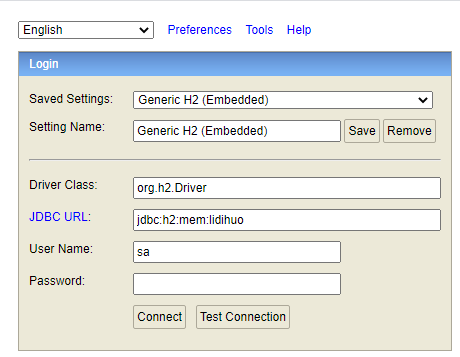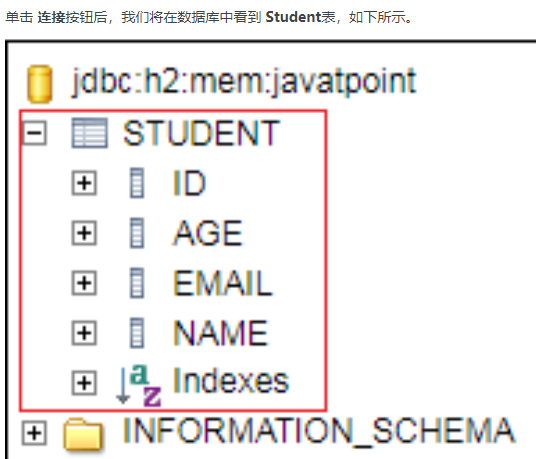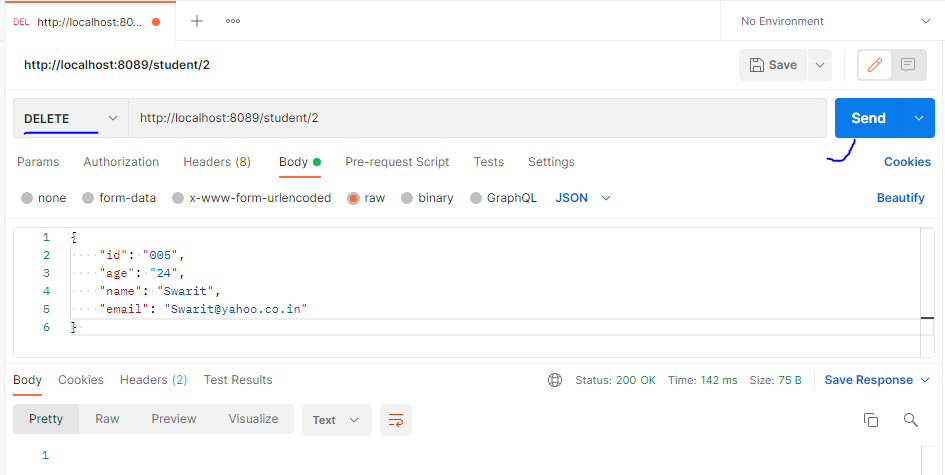什么是内存数据库
内存数据库依赖于系统内存而不是磁盘数据存储空间。因为内存访问比磁盘访问快。当我们不需要持久化数据时,我们使用内存数据库。内存数据库是嵌入式数据库。默认情况下,内存数据库是易失性的,当我们重新启动应用程序时,所有存储的数据都会丢失。
广泛使用的内存数据库是 H2,HSQLDB (HyperSQL数据库) ,和 Apache Derby。 它会自动创建配置。
持久性与内存数据库
持久性数据库将数据持久存储在物理内存中。即使数据库服务器退回,数据也将可用。一些流行的持久性数据库是 Oracle , MySQL , Postgres ,等。
在对于 内存数据库,数据存储在 系统内存中。程序关闭时丢失了数据。它对 POC (概念证明)很有帮助,而不对生产应用程序有用。广泛使用的内存数据库是 H2。
什么是H2数据库 H2 是 嵌入式,开源和 内存数据库。它是用 Java 编写的关系数据库管理系统。这是一个 客户端/服务器应用程序。它通常用于 单元测试。它将数据存储在内存中,而不是将数据持久存储在磁盘上。 优点 零配置 易于使用。 轻巧,快速。 它提供了简单的配置,可以在真实数据库和内存数据库之间切换。 它支持标准的SQL和JDBC API。 它提供了一个可在数据库中维护的Web控制台。 配置H2数据库 如果要在应用程序中使用H2数据库,则需要在pom.xml文件中添加以下依赖项: <dependency> <groupId>com.h2database</groupId> <artifactId>h2</artifactId> <scope>runtime</scope> </dependency> 添加依赖项后,我们需要配置H2数据库的 数据源URL,驱动程序类名称,用户名和 密码。 Spring Boot提供了一种简单的方法来配置 application.properties 文件中的这些属性。 spring.datasource.url=jdbc:h2:mem:testdb spring.datasource.driverClassName=org.h2.Driver spring.datasource.username=sa spring.datasource.password= spring.jpa.database-platform=org.hibernate.dialect.H2Dialect 在 spring.datasource.url 属性中, mem 是内存数据库的名称,而 testdb 是内存数据库的名称。默认情况下,H2提供的架构。我们还可以定义自己的架构和数据库。默认用户名是 sa ,空白密码表示 空密码。如果要更改用户名和密码,可以覆盖这些值。 将数据保留在H2数据库中 如果要将数据保留在在H2数据库中,我们应该将数据存储在一个文件中。为此,我们需要更改数据源的 URL 属性。 #persist the data spring.datasource.url=jdbc:h2:file:/data/sampledata spring.datasource.url=jdbc:h2:C:/data/sampledata 在上面的属性中, sampledata 是一个文件名。
创建Schema构并填充数据 我们可以定义通过在 resource 文件夹(src)中创建 SQL 文件创建架构/main/resource)。 schema.sql DROP TABLE if EXISTS CITY; CREATE TABLE CITY ( City_code int AUTO_INCREMENT PRIMARY KEY, city_name VARCHAR(50) NOT null, city_pincode INT(8) NOT null, ); 我们可以通过在 resource 文件夹(src/main/resource)中创建一个 SQL 文件来填充表中的数据。 data.sql INSERT INTO CITY VALUES ('Delhi', 110001); INSERT INTO CITY VALUES ('Kanpur', 208001); INSERT INTO CITY VALUES ('Lucknow', 226001); Spring Boot在应用程序启动期间自动拾取 data.sql 文件并针对H2数据库运行它。 H2控制台 默认情况下,禁用H2数据库的控制台视图。在访问H2数据库之前,我们必须使用以下属性启用它。 #enabling the H2 console spring.h2.console.enabled=true 一旦启用了H2控制台,现在我们可以通过调用URL http://localhost:8089/h2-console在浏览器中访问H2控制台。下图显示了H2数据库的控制台视图。

<project xmlns="http://maven.apache.org/POM/4.0.0" xmlns:xsi="http://www.w3.org/2001/XMLSchema-instance" xsi:schemaLocation="http://maven.apache.org/POM/4.0.0 http://maven.apache.org/xsd/maven-4.0.0.xsd"> <modelVersion>4.0.0</modelVersion> <groupId>com.tszy</groupId> <artifactId>H2</artifactId> <version>0.0.1-SNAPSHOT</version> <parent> <groupId>org.springframework.boot</groupId> <artifactId>spring-boot-starter-parent</artifactId> <version>2.0.0.RELEASE</version> <relativePath /> <!-- lookup parent from repository --> </parent> <dependencies> <dependency> <groupId>org.springframework.boot</groupId> <artifactId>spring-boot-starter-data-jpa</artifactId> </dependency> <dependency> <groupId>org.springframework.boot</groupId> <artifactId>spring-boot-starter-web</artifactId> </dependency> <!-- DevTools in Spring Boot 项目热部署 --> <dependency> <groupId>org.springframework.boot</groupId> <artifactId>spring-boot-devtools</artifactId> </dependency> <dependency> <groupId>com.h2database</groupId> <artifactId>h2</artifactId> <scope>runtime</scope> </dependency> <dependency> <groupId>org.springframework.boot</groupId> <artifactId>spring-boot-starter-test</artifactId> <scope>test</scope> </dependency> </dependencies> <build> <plugins> <plugin> <artifactId>maven-compiler-plugin</artifactId> <configuration> <source>1.8</source> <target>1.8</target> </configuration> </plugin> </plugins> </build> </project>
server.port=8089
spring.datasource.url=jdbc:h2:mem:lidihuo
spring.datasource.driverClassName=org.h2.Driver
spring.datasource.username=sa
spring.datasource.password=
spring.jpa.database-platform=org.hibernate.dialect.H2Dialect
#enabling the H2 console
spring.h2.console.enabled=true
package com.lidihuo.model; import javax.persistence.Column; import javax.persistence.Entity; import javax.persistence.Id; import javax.persistence.Table; //mark class as an Entity @Entity //defining class name as Table name @Table public class Student { // mark id as primary key @Id // defining id as column name @Column private int id; // defining name as column name @Column private String name; // defining age as column name @Column private int age; // defining email as column name @Column private String email; public int getId() { return id; } public void setId(int id) { this.id = id; } public String getName() { return name; } public void setName(String name) { this.name = name; } public int getAge() { return age; } public void setAge(int age) { this.age = age; } public String getEmail() { return email; } public void setEmail(String email) { this.email = email; } }
package com.lidihuo.model; import java.util.List; import org.springframework.beans.factory.annotation.Autowired; import org.springframework.web.bind.annotation.DeleteMapping; import org.springframework.web.bind.annotation.GetMapping; import org.springframework.web.bind.annotation.PathVariable; import org.springframework.web.bind.annotation.PostMapping; import org.springframework.web.bind.annotation.RequestBody; import org.springframework.web.bind.annotation.RestController; import com.lidihuo.model.Student; import com.lidihuo.model.StudentService; //creating RestController @RestController public class StudentController { // autowired the StudentService class @Autowired StudentService studentService; // creating a get mapping that retrieves all the students detail from the // database @GetMapping("/student") private List<Student> getAllStudent() { return studentService.getAllStudent(); } // creating a get mapping that retrieves the detail of a specific student @GetMapping("/student/{id}") private Student getStudent(@PathVariable("id") int id) { return studentService.getStudentById(id); } // creating a delete mapping that deletes a specific student @DeleteMapping("/student/{id}") private void deleteStudent(@PathVariable("id") int id) { studentService.delete(id); } // creating post mapping that post the student detail in the database @PostMapping("/student") private int saveStudent(@RequestBody Student student) { studentService.saveOrUpdate(student); return student.getId(); } }
package com.lidihuo.model; import java.util.ArrayList; import java.util.List; import org.springframework.beans.factory.annotation.Autowired; import org.springframework.stereotype.Service; import com.lidihuo.model.Student; import com.lidihuo.model.StudentRepository; @Service public class StudentService { @Autowired StudentRepository studentRepository; // getting all student records public List<Student> getAllStudent() { List<Student> students = new ArrayList<Student>(); studentRepository.findAll().forEach(student -> students.add(student)); return students; } // getting a specific record public Student getStudentById(int id) { return studentRepository.findById(id).get(); } public void saveOrUpdate(Student student) { studentRepository.save(student); } // deleting a specific record public void delete(int id) { studentRepository.deleteById(id); } }
package com.lidihuo.model; import org.springframework.data.repository.CrudRepository; import com.lidihuo.model.Student; public interface StudentRepository extends CrudRepository<Student, Integer> { }
package com.lidihuo.model; import org.springframework.boot.SpringApplication; import org.springframework.boot.autoconfigure.SpringBootApplication; @SpringBootApplication public class SpringBootH2DatabaseExampleApplication { public static void main(String[] args) { SpringApplication.run(SpringBootH2DatabaseExampleApplication.class, args); } }

打开浏览器并调用URL http://localhost:8089/h2-console。单击 Connect 按钮,如下所示。


单击 Student表,然后单击 运行按钮。该表显示了我们插入到正文中的数据。

打开Postman并发送 GET 请求。它返回我们已经插入数据库中的数据。

调用了URL http://localhost:8080/student/3。它返回ID为3的学生的详细信息。

假设我们要删除ID为2的学生记录。 要删除学生记录,请发送带有URL http://localhost:8089/student/的 DELETE 请求。我们看到ID为 2 的学生已从数据库中删除。





